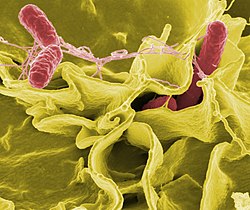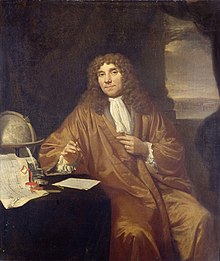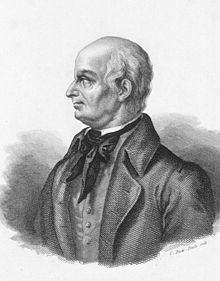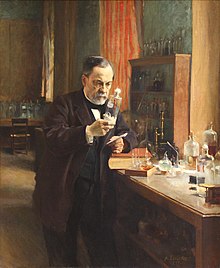Microorganism
A microorganism, also called a microbe (from the scientific Greek μικρόβιος [microbes]; from μικρός [micrós ], "small", and βίος [bíos], 'life'; tiny living being) or microbiont, It is a living being or a biological system that can only be visualized with a microscope. They are organisms endowed with individuality (unicellular) that present, unlike plants and animals, an elementary biological organization. The scientific discipline that studies microorganisms is microbiology.
The concept of microorganism is operative and lacks any taxonomic or phylogenetic implications, since it encompasses heterogeneous unicellular organisms, which are not evolutionarily related to each other, such as bacteria, archaea (prokaryotes), protozoa, microscopic algae and microscopic fungi (eukaryotes).
Microbes come in many shapes and sizes. If an average-sized virus was the size of a tennis ball, a bacterium would be the size of half a tennis court, and a eukaryotic cell would be the size of a football stadium.
Some microorganisms are pathogens and cause diseases in people, animals and plants, some of which have plagued humanity since time immemorial. However, the vast majority of microbes are not harmful at all and quite a few play a key role in the biosphere by providing oxygen (algae and cyanobacteria), and others by decomposing organic matter, mineralizing it and making it accessible again to humans. producers, closing the cycle of matter.
History of the discovery of microorganisms
Antonie van Leeuwenhoek (1632–1723) was one of the first to observe microorganisms, using microscopes of his own design. Robert Hooke, a contemporary of Leeuwenhoek, also used microscopes to observe microbial life; In his 1665 book, Micrographia, he described those observations and coined the term cell.
Before Leeuwenhoek's discovery of microorganisms in 1675, it had been a mystery why grapes could turn into wine, milk into cheese, or why food spoiled. Leeuwenhoek did not make the connection between these processes and microorganisms, but using a microscope he established that there were signs of life there that were not visible to the naked eye. Leeuwenhoek's discovery, along with later observations by Spallanzani and Pasteur, ended with the ancient belief that life appeared spontaneously from substances killed during the process of decay.
Lazzaro Spallanzani (1729–1799) found that boiling broth sterilized it, killing the microorganisms in it. He also found that new microorganisms could only take up residence in a broth if the broth was exposed to air.
Louis Pasteur (1822–1895) expanded on Spallanzani's findings by exposing boiled broths to air, in containers containing a filter that prevented any particles from entering the growth medium, and also in containers without any filters, which they admitted air through a curved tube that did not allow dust particles to come into contact with the broth. By boiling the broth in advance, Pasteur ensured that there were no surviving microorganisms in the broths at the start of the experiment. Nothing grew in the broths in the course of Pasteur's experiment. This meant that the living organisms that grew in these broths came from outside, as powdered spores, rather than spontaneously generated in the broth. Therefore, Pasteur dealt the blow to the theory of spontaneous generation, giving support to the microbial theory of disease.
In 1876 Robert Koch (1843–1910) established that microorganisms can cause disease. He found that the blood of cattle that was infected with anthrax always had large numbers of Bacillus anthracis .
Koch discovered that he could transmit anthrax from one animal to another by taking a small blood sample from an infected animal and injecting it into a healthy one, which made the animal sick. He also discovered that he could grow the bacteria in a nutrient broth, then inject it into a healthy animal, and cause disease. Based on these experiments, he devised the criteria for establishing a causal relationship between a microorganism and a disease, now known as the Koch postulates. Although these postulates cannot be applied in all cases, they retain their historical importance in the development of scientific thought. and are still used today.
On November 8, 2013, the discovery of what may be the first signs of life on Earth was reported: the oldest complete fossils of a microbial mat (associated with sandstone in Western Australia) estimated to be 3,480 years old. millions of years.
Classes of Microorganisms
In microorganisms four groups of beings are represented: bacteria, archaea, protists and fungi. Viruses are generally not considered living beings and in fact they are more associated with mobile genetic elements, viroids and prions, which is why they are not considered microorganisms, although virology, the study of viruses, is a subfield of microbiology..
Prokaryotic Microorganisms
Bacteria and archaea are prokaryotic microorganisms with a spherical shape (cocci), straight rods (bacilli) or curved rods (vibrios), or spirals (spirilla). They can exist as individual organisms, forming chains, pairs, tetrads, irregular masses, etc. Bacteria are one of the most abundant life forms on earth. They have a length between 0.4 and 14 μm. Consequently they can only be seen under a microscope. Bacteria reproduce by multiplying DNA, and dividing into two independent cells; Under normal circumstances this process takes between 30 and 60 minutes.
When environmental conditions are unfavorable, when the temperature changes or the amount of nutrients decreases, certain bacteria form endospores as a defense mechanism, characterized by presenting a protective layer that is resistant to heat, drying, radiation, and mechanical shredding and protects the bacteria very efficiently. In this way, they can withstand high temperatures, periods of drought, frost, etc. When environmental conditions improve, a new bacterium develops that continues to grow and multiply.
Bacteria have a specific ecological functional role. For example, some carry out the degradation of organic matter, others integrate their metabolism with that of human beings.
Although some bacteria are pathogenic (causing various diseases), a large part of them are harmless or even good for health.
Eukaryotic Microorganisms
Eukaryotes are all cells that have their hereditary material (their genetic information) enclosed within a double membrane, the nuclear envelope, which delimits a cell nucleus.
There are three types of eukaryotic microorganisms, protozoa (heterotrophs and without cell walls), microscopic algae (autotrophs and cellulose cell walls) and microscopic fungi (heterotrophs and chitin cell walls).
Protists
Protozoa and microscopic algae are single-celled microorganisms of the kingdom Protista that range in size from 10-60 μm to more than 1 millimeter, and can easily be seen through a microscope. They live in humid environments or directly in aquatic environments, whether they are salt water or fresh water. Reproduction can be asexual by bipartition and also sexual by isogametes or by conjugation exchanging genetic material. Protozoa are heterotrophs, phagotrophs, predators or detritus eaters, sometimes mixotrophs (partly autotrophs), while microscopic algae are autotrophs, however some may be mixotrophs (partly autotrophs).
The kingdom Protista includes very diverse groups, some of which are related to the origin of animals, fungi and plants, which is why it is considered a paraphyletic taxon.
Mushrooms
The kingdom Fungi includes a variety of macroscopic species that do not fit the definition of a microorganism at all, but also microscopic forms, such as yeasts, which are the field of study of microbiology. Fungi have a wide range of habitats, including extreme environments such as deserts, areas of extreme salinity, exposed to ionizing radiation, or in seabed sediments; most are terrestrial, although some, such as Batrachochytrium dendrobatidis, are strictly aquatic. In addition, numerous fungi cause infectious diseases in animals and plants and are of great health and agricultural interest.
Pathogenic microorganisms
Some microorganisms are capable of penetrating and multiplying in other living beings, harming them, causing an infection; They are called pathogenic microorganisms. The problems caused by an infection depend on the type of pathogen, the way it is transferred, the dose or concentration of pathogens, the persistence of microorganisms, and the resistance of the infected organism.
Dose of infection means the number of microorganisms. This dose is very low for parasitic protozoa. The persistence of microorganisms depends on the viability of the microorganisms when they are not found in the human host. For example, bacteria are generally less persistent while protozoan cysts are the most persistent.
Young people, the elderly and patients with other pathologies are the least resistant to diseases and are therefore more vulnerable. When a person is infected, the pathogens multiply in them, and this poses a risk of infection or disease.
People who get sick can infect and spread the disease through secretions and through direct contact in some way with the mucosa of the infected person.
Growing methods
There are two major classifications in terms of culture methods for microorganisms: aerobic and anaerobic. Normally, they are incubated under aerobic conditions, that is, under normal atmospheric conditions; this technique is the simplest. With it, aerobic and facultative anaerobic microorganisms proliferate in the same way. However, some isolated bacteria only reproduce under strictly anaerobic conditions. Thus, it is necessary to resort to a culture medium in which all the atmospheric oxygen has previously been eliminated and has been replaced by another gas (nitrogen).
Contenido relacionado
European System of Accounts
Nekton
Saugetia





